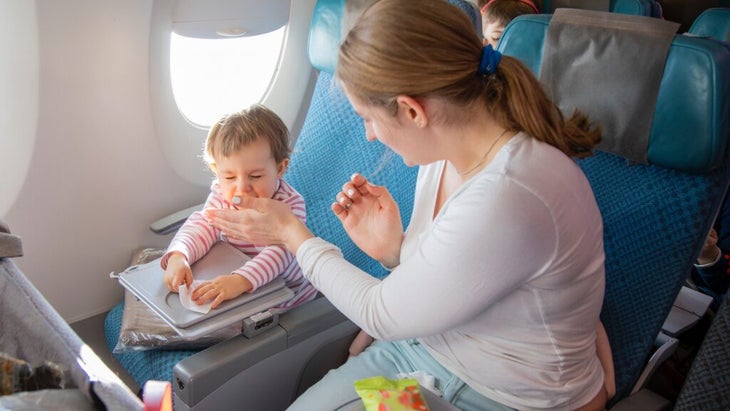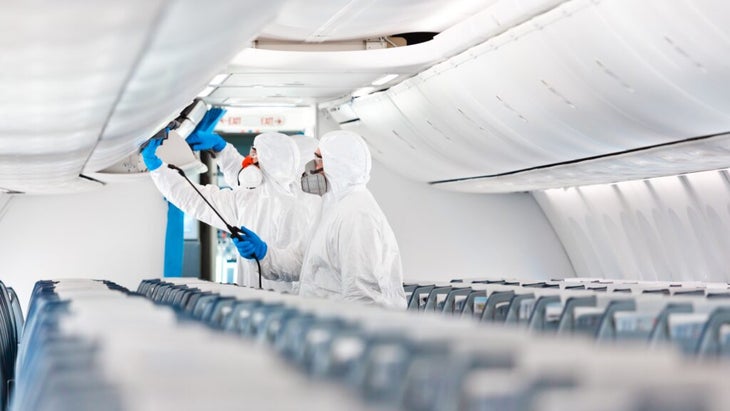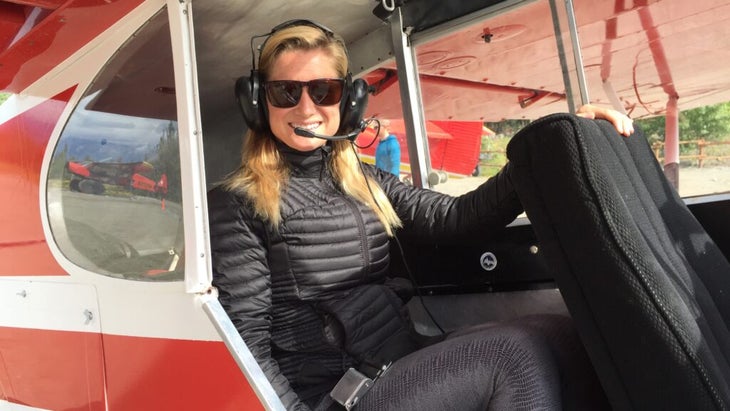I’m worried about all the germs I keep reading about on planes these days. The news continues to report on nasty stuff that’s seemingly on every surface, ready to make passengers sick. The holidays are coming up, and I have to fly. How much should I worry? —Disgusted and Dismayed
I am not a germophobe. But I fly more than a third of the year, and planes are starting to gross me out, too. On a recent flight from Denver to Hokkaido, Japan, I shoved my laptop into the back-seat pocket before takeoff, and when I pulled it out, a wad of dirty Kleenex was stuck to the bottom. This summer I watched the woman seated next to me shove her baby’s dirty diaper in her back-seat pocket. When I gave her the stink eye, she simply replied, “What? They clean these things later.” But do they really? I wondered.
The gross factor of these incidents pales in comparison to this summer’s horror stories of of a Delta flight and passengers being kicked off an Air Canada flight after refusing to sit in . Between news headlines and first-person observations, planes seem germier than ever.
“I threw up on a plane recently, and there was no barf bag, and we were landing so I couldn’t ask for one,” one �����ԹϺ��� editor told me. “Despite trying to contain it in my scarf, it splashed everywhere, and I thought to myself afterward, There is no way the cleaners can find every last droplet of the vomit. It gave me pause about how clean the seat and floor are for future travel.”
What Are the Dirtiest Spots on a Plane?

In plenty of instances, I’ve boarded a plane only to discover my seat littered with M&Ms and pretzels from the previous passenger. But seats aren’t the worst offenders. Multiple studies over the years have concluded that the grimiest spots on a plane are tray tables and any areas that are touched in the bathroom.
A by TravelMath, a search engine that answers data-related questions about travel, tested samples from hard surfaces in planes and found that tray-table surfaces had more than eight times the amount of bacteria per square inch than even the lavatory flush buttons. The trays had 2,155 colony-forming units of bacteria per square inch; in comparison, a home toilet seat typically has 127, according to the National Science Foundation.
A test conducted by a travel reporter at earlier this year further substantiates these problem areas on planes. The reporter used a germ-detecting swab device on ten touch points on a plane, and nine failed (read: showed alarming quantities of bacteria). The bathroom sink handle had the highest number of germs; the tray table was runner-up.
Chuck Gerba, a professor of virology in the department of environmental science at the University of Arizona, says his research has shown tray tables and the door latch in the lavatory to be the germiest spots on planes (his studies detected fecal matter on some handles), closely followed by the latches on overhead luggage-storage compartments.
And there’s one more place you should be aware of: drink cans. I typically forgo a plastic cup and drink seltzer water straight from the can to reduce waste, but Gerba told me I might want to rethink that decision (or use an eco-friendly straw). The tops of those cans, along with airline coffee pots, can be festering with bacteria.
Should You Worry About Getting Sick on a Plane?
Before you go buying a hazmat suit for your next flight, consider that germs found on surfaces in planes are comparable to what you were probably just exposed to in the airport, says William Schaffner, a professor in the Division of Infectious Diseases at Vanderbilt University. “Any environment where surfaces are constantly being touched by multiple people—be it a hotel lobby, plane, or airport waiting-area seat—is going to have germs,” he says.
However, researchers at Auburn University have found that potentially deadly bacteria, including E.coli and MRSA, are able to live on airplane surfaces like tray tables, seat pockets, and armrests for up to a week.
People are far more likely—113 times more, by one study’s measures—to catch the common cold from airborne transmission during a flight than on the ground in the airport or at the supermarket.
Diseases that can spread when you come into contact with a contaminated object include norovirus, which causes gastrointestinal distress and is sometimes called the cruise-ship virus. The nickname, notes Schaffner, stems from the fact that this illness is easy to contract on a cruise ship, where you’re in close quarters but interact a lot with multiple people for multiple days. That said, contracting norovirus on a plane is very rare, he says, even on a long-haul flight, because passengers are in close contact with a much smaller number of people for a shorter period of time.
The simple solution to avoiding bacterial germs on a plane—or anywhere for that matter—is by practicing good hygiene: wash your hands frequently, wipe down surfaces with sanitizer, and use hand sanitizer after touching surfaces, says Aniruddha Deshpande, a doctoral student researcher in the epidemiology department of Emory University’s Rollins School of Public Health. Also try to avoid touching your face and eyes while traveling.
Have Cleaning Practices Changed Since COVID?

During the height of the pandemic, air carriers adopted superior cleaning protocols. American Airlines, for example, sprayed the walls, side panels, flight deck, and entryways of its planes weekly with an electrostatic cleaning agent approved by the FDA to provide seven-day protection against bacteria, mold, and viruses. They also used a hospital-grade disinfectant to wipe down 81 specific touch points (such as tray tables and seat belts) before every departure.
Those strict standards seem to have since lapsed, perhaps because pre-pandemic flight schedules have resumed. Some news stories have blamed for this. But according to recent from Airlines for America (A4A), which advocates for the industry, passenger airlines have reported employing more workers than they have in the past 20 years.
In an attempt to inquire whether, or to what extent, cleaning measures have been reduced, I reached out to a dozen airline representatives, including at Air Canada, American Airlines, Delta, Southwest, and United. All declined to comment. notes that its disinfection procedures have been certified by Lysol Pro Solutions, and says that “an electrostatic disinfectant and an anti-microbial spray are applied on every surface of the aircraft, killing viruses on contact and forming an anti-microbial coating or shield for 30 days. Every night, we deep clean each plane from nose to tail for more than 6 hours.”
A representative for Airlines for America emailed me this reply: “The safety and wellbeing of our passengers and crew is the top priority of the U.S. airline industry. A4A passenger carriers work to keep the cabin clean for passengers and utilize specific measures to ensure a clean and comfortable cabin area for their passengers.”
Do planes feel less clean to you? From my own experiences, as well as reports from passengers and the , many agree that not enough is being done.
Airlines aren’t penalized for dirty planes, nor are cleaning practices federally regulated, according to Dave Daigle, a spokesperson for the Centers for Disease Control and Prevention. And while the CDC offers on cleaning protocols and how to prevent the spread of disease if a passenger is demonstrably ill, Daigle says that it is up to individual airline companies to implement their own sanitation procedures.
Consider Masking Up Onboard
While many of us worry about bacterial germs festering on surfaces, the real concern is respiratory viruses floating in the air, according to experts. A 2004 in the Journal of Environmental Health Research found that people are far more likely—113 times more, by one of the study’s measures—to catch the from airborne transmission during a flight than on the ground in the airport or at the supermarket.
Other airborne diseases that have been transmitted on planes include the flu and COVID, Emory’s Deshpande says. Instances have been documented of more dangerous infectious diseases, such as tuberculosis, being passed around due to someone traveling with an active TB infection, but these cases are rare, he says.
“Proximity repeatedly is featured as a major risk factor when disease or illness outbreaks on planes are analyzed,” Deshpande says. “Planes are equipped with air filters, which does help mitigate the risk if you’re seated far away from someone sick, but if you’re seated within one to two rows away, the risk of infection could be high regardless.”
Upgrading to first or business class won’t help you avoid surface germs, as all sections of planes are cleaned the same way, but it could help you avoid catching a cold (or other airborne diseases) because these pricier sections tend to be spaced farther apart from other passengers.
Gerba, the Arizona virologist, did have a good tip for anyone sitting in first-class or business seats: Since every passenger on the plane has to head through your section to get to their seats, consider waiting to board. “If everyone is walking past you sneezing and coughing, you’re exposed to infectious droplets,” he says.
Not long ago, Schaffner took his first post-COVID flight from Nashville, Tennessee, to Washington, D.C., and he masked up because he’s in a “gray-hair, high-risk group” and because it’s flu season.
Whether you choose to mask up or not, there’s no harm in speaking up if you are grossed out. I was recently seated next to a man hacking loudly, and when I voiced my concern to the flight attendant, she was able to move me to an empty spot four rows away.

Jen Murphy dreams of the day she’s not forced to sit in the middle seat in the last row of economy. Her far-flung assignments often require air transfer by helicopter or small charter planes.


